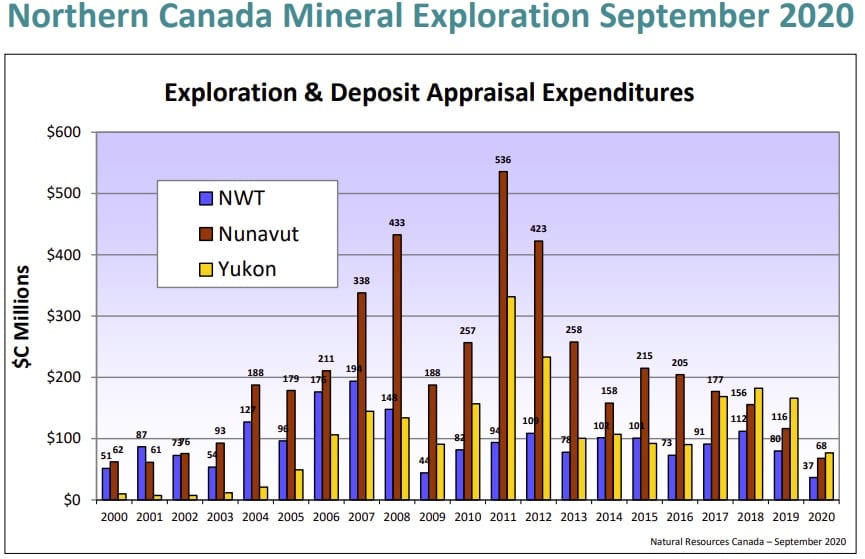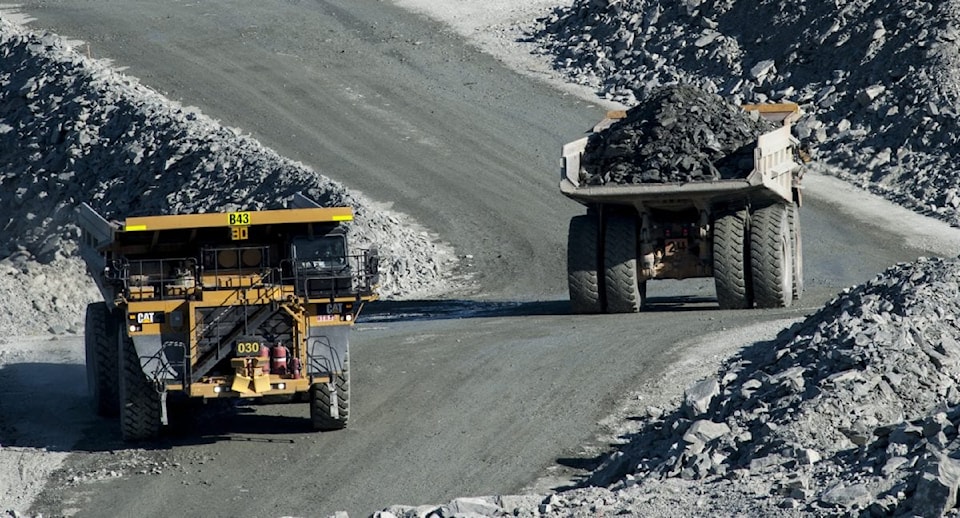The NWT & Nunavut Chamber of Mines is concerned about the ongoing decreases in mineral exploration expenditures in the North, which is expected to decline by about half from 2019 to 2020 and reach the lowest level in 20 years in the NWT.
Statistics from Natural Resources Canada (NRCan) show that in the NWT, expenditures are expected to drop by 54 per cent, to $36.6 million in 2020 from $79.8 million in 2019. The figures for 2020 cover the period until September. The expenditures are the costs of searching for and appraising mineral deposits.
The 2020 level is the lowest for the NWT in the last two decades, according to a summary graph based on NRCan that the Chamber of Mines published on Thursday. The last time exploration expenditures dropped to a comparable level was in 2009, when they came to $44 million. They peaked at $194 million in 2007.

The NWT's exploration spending has also lagged behind Yukon and Nunavut almost every year since 2009.
Nunavut's exploration expenditures are projected to fall to $68 million in 2020 from $116.4 million in 2019, a reduction of 42 per cent, the third lowest level for Nunavut since 2000. Its lowest was $61 million in 2001 and its highest was $536 million 2011.
Along with the NWT, the Yukon's proportion of expenditures is expected to fall by 54 per cent for 2020, down to $76.9 million in 2020, from $166.2 million in expenditures in 2019.
The figures for the North come as exploration spending for the provinces is expected to increase.
All provinces spent just over $1.92 billion in 2019 on exploration and that number is projected to rise by two per cent in 2020 to $1.95 billion. Expenditures across Canada are due to decrease by six per cent to $2.14 billion in 2020, from $2.28 billion in 2019.
Chamber of Mines president Ken Armstrong said the decline in mineral exploration investment isn't surprising due to the difficulties industries are experiencing from the Covid-19 pandemic.
"However, the drop is worrisome when compared to southern Canada where, despite pandemic-related restrictions and program delays, exploration spending increased," he said, citing the report showing that in Ontario exploration spending rose by seven per cent in 2020 compared to 2019 and by 17 per cent in Quebec.
“This difference in exploration expenditures between Canada’s three territories and the provinces highlights the significant challenges to Northern resource development," Armstrong said.
Although pre-Covid declines in the NWT were occurring partly because of the high costs of exploration and unsettled land claims, the pandemic has worsened the prospects for further mining investment, explained Chamber of Mines executive director Tom Hoefer.
Exploration companies have been put in an uncertain position for several reasons, such as the rules of the Canada Emergency Wage Subsidy (CEWS) program excluding the companies because of their unique revenue model, Hoefer stated in an email.
"Some projects (also) were near communities (eg, North Arrow’s Naujaat project, where workers normally lived in the community of Naujaat), and the communities asked them not to come."
Another reason is that self-isolation requirements for people entering the NWT deterred some exploration programs, whose employees mostly come from the south.
But Hoefer said the chamber is working with the federal and territorial governments to help ensure the North can emerge stronger from the pandemic and even exceed pre-Covid levels of activity.
"An example of an initiative we are urging is an enhanced mineral exploration tax credit for North of 60, so that it not only offsets the higher costs of working here, but also adds an additional incentive for investors to come to the North," he said.
Finance minister Caroline Wawzonek said the report's findings were somewhat expected as the global market for resources companies has been unfavourable even before the pandemic hit.
"Some commodities prices are suffering such as the global diamond market, financial markets are risk-averse and the competition for exploration and development dollars is strong," Wawzonek said. "This is a tough environment for junior exploration companies to operate in."
Wawzonek explained that the start of a recovery is evident but it will likely happen in areas of easy access and low overhead.
"Coming out of this pandemic, (the NWT) needs to make the argument that we are open for resource investment – and that opportunity in the North is still strong," she said.
Reiterating some points she made in her Nov. 3 statement on the benefits and importance of the mineral resource sector, Wawzonek said the GNWT will continue to recognize the value of mine workers to the territory; highlight the competitiveness of the NWT to investors;
complete the work required to implement the Mineral Resources Act, including developing new regulations; develop and implement Regional Mineral Strategies; increase collaboration and investment with Indigenous governments; and promote the NWT as a source of critical and strategic minerals and metals.
